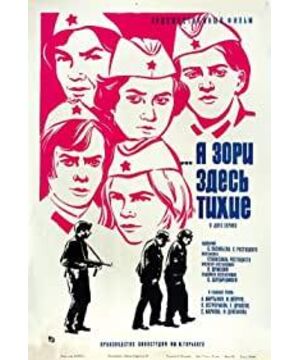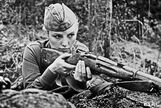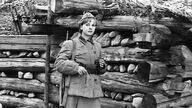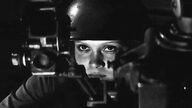This film is an adaptation of a literary work, so the first problem the adaptor faces is the narrative structure of the film. The film examines the past war with the eyes of modern people, so as to think about the reality of today. The novel provides a straightforward and objective account of the protagonists' pre-war and combat lives, while the film uses a contrasting approach. In the first episode of the film, the adaptor used two sets of shots to express the dreamy and beautiful love of the female machine gunners before the war and the fighting life in cruel reality, and turned the objective narrative of the heroine's past in the novel into a their subjective memories. In this way, the narrative structure of the film becomes multi-perspective, with both the objective presentation of the film author and the subjective memory of the protagonist. In order not to make the film fragmented by the interspersed interludes of the past, the adaptor asked the girls to focus on the memories of the love that symbolized the beautiful youth or their longing for love in their pre-war life, and put the memories of the five girls together. All focus on the first episode of the film.
In the reminiscence shot, the filmmaker fully mobilized the means of visual art, and used a set of ethereal and elusive color pictures like soap bubbles to express the happiness that the female machine gunners have had or may have. In that set of pictures, everything is rosy, azure, and bling, beautiful, seductive and unreal like a fairyland. The filmmakers used another set of grim black-and-white images to show the real combat lives of the female fighters. These two sets of images appear alternately, making the audience realize how beautiful the lives of these girls would have been without the fascist war of aggression, and the cruel Deko completely changed their lives. They were tested by war without being mentally prepared for war. This further shows the cruelty of the fascist war of aggression. The film expresses the war itself as the object of condemnation. The audience can see from the film that war is in no way compatible with human civilization and personal happiness. In the film, the confluence of the two sets of images of memory and reality not only shows the heroines' love for life, but also praises their patriotic spirit of not afraid of sacrifice.
This set of colorful memory pictures uses hypothetical and virtual methods, with large capacity and strong expressiveness. The filmmakers tried to use a few pictures and a few sparse dialogues to outline the different past events of the girls, and found a unique and appropriate artistic treatment for each girl's memories. method. The memories of the five girls constitute a beautiful and peaceful world full of youth and vitality.
Warrant Officer Vaskov's experience is also an objective narrative of the author in the novel. On the screen, Vaskov himself tells the major, and part is introduced to the women's volleyball captain Kiryanova through the landlady Maria. The film does not directly use the picture to show Vaskov's past, because he is a soldier, and the war is his duty. For him, life before and after the war was not in stark contrast. The new test that the war brought him was dealing with such a group of girls who had attended ten-year schools, had never fought a war, and did not understand the rules of battle at all. The war brought together a soldier from the countryside like Vaskov and a group of female warriors who chattered like schoolgirls. The film does not specifically describe Vaskov's image, but shows his unique and not single character through the changes in his relationship with the female warriors. Before Vaskov and the five girls went to the forest to hunt down Deko, his relationship with these female soldiers was incompatible, and the gap was huge in all aspects. It was this sudden combat mission that prompted a profound change in the relationship between Vaskov and the girls. In the process of performing the task, the distance between them gradually shortened. For Vaskov, what pained him most was seeing the girls die one by one, and there was nothing he could do about it. The girls are immersed in happy love and encounter a war, and they die unexpectedly when they think they will win. This treatment is different from many previous war movies. For example, in films such as "Young Guards", the protagonist shouted slogans and died heroically for the country. In this film, it is emphasized that wars come to people suddenly like disasters and plagues when people are unprepared.
Another important theme of the film is: war was not supposed to be about these girls, girls should be associated with all the good things in life, but the cursed fascism forced these girls to lose their youth in the war and life. In the scene of Lisa's sacrifice in the swamp, her body fell into the mud and sank rapidly. She cried out for help, but no one heard her except for a scream and her head buried in the mud. A small branch exposed on the swamp swayed a few times and stopped, and the water surface of the swamp was still. It makes one feel: as if all life has stopped, the audience is suddenly breathless at Lisa's tragic death. The film is shocking with its strong artistic appeal.
The moving power of the film mainly comes from its authenticity, which is as simple and natural as life itself. The film not only shows the heroic sacrifice of the protagonists, but also highlights their love for life. For example, when the girls were taking a bath, everyone praised Zania's body as beautiful as a sculpture. A girl said, "It's a pity that such a beautiful body is wearing a military uniform!" The filmmakers meant to show that it was the fascists who forced them to wear military uniforms, and that such a beautiful, defenseless body could one day be bullets. will hit them. This further highlights the cruelty of the war launched by the German fascists. It not only interrupted the beautiful and peaceful lives of the girls, but also took away their youth and lives.
After watching the film, the audience may not cry, but their hearts seem to be blocked by something, and they can't speak for a while, as if a group of old friends they knew suddenly passed away, and their voices and smiles are still vivid in their minds. , makes people feel infinitely melancholy... Through this film, director Rostotsky discovered a group of new actors. Although these young actresses had never participated in the Great Patriotic War, they were in the original author and screenwriter who experienced the war. With the inspiration and help of the director and photographer, they felt the atmosphere of the Great Patriotic War, thus truly reproducing the image of their predecessors.
View more about The Dawns Here Are Quiet reviews






